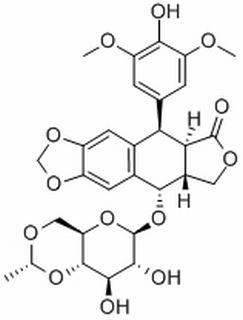Home
Products
Etoposide



| Product Name | Etoposide |
| Price: | $31 / 20mg |
| Catalog No.: | CN02725 |
| CAS No.: | 33419-42-0 |
| Molecular Formula: | C29H32O13 |
| Molecular Weight: | 588.56 g/mol |
| Purity: | >=98% |
| Type of Compound: | Lignans |
| Physical Desc.: | Powder |
| Source: | The herbs of Dysosma versipellis. |
| Solvent: | Chloroform, Dichloromethane, Ethyl Acetate, DMSO, Acetone, etc. |
| SMILES: | COc1cc(cc(c1O)OC)[C@H]1[C@H]2C(=O)OC[C@@H]2[C@@H](c2c1cc1OCOc1c2)O[C@@H]1OC2CO[C@H](O[C@H]2[C@@H]([C@H]1O)O)C |
| Contact us | |
|---|---|
| First Name: | |
| Last Name: | |
| E-mail: | |
| Question: | |
| Description | Etoposide is a chemotherapy medication used for the treatments of a number of types of cancer. Etoposide inhibits DNA synthesis by forming a complex with topoisomerase II and DNA. |
| Target | Topoisomerase II |
| In Vitro | Etoposide is capable of causing cytotoxicity on pancreatic β-cells by inducing apoptosis through the JNK/ERK-mediated GSK-3 downstream-triggered mitochondria-dependent signaling pathway in RIN-m5F cells[1]. Etoposide and Bevacizumab significantly abolish P1 sphere-forming ability, an effect associated with apoptosis of this subset of cells[2]. |
| In Vivo | Etoposide (50 μM) and Bevacizumab-treated hypoxic cells injected intravenously into immunodeficient mice reveals a reduced capacity to induce lung colonies, which also appear with a longer latency period[2]. Etoposide (10 mg/kg/day, i.v.) with ifosfamide and carboplatin, reduces the tumor volume in the hepatoblastoma cell injected NMRI nude mice[3]. |
| Cell Assay | RIN-m5F cell is a rat pancreatic β-cell line, and cultured in a humidified chamber with a 5% CO2-95% air mixture at 37°C and maintained in RPIM 1640 medium supplemented with 10% fetal bovine serum (FBS) and antibiotics (100 U/mL of penicillin and 100 μg/mL of streptomycin). RIN-m5F cells are seeded (2 × 104 cells/well) in 96-well plates and allowed to adhere and recover overnight. The cells are changed to fresh media and then incubated with Etoposide (1-100 μM) in the absence or presence of the pharmacological inhibitors (lithium chloride (LiCl)-50 μM; SP600125-20 μM; PD98059-20 μM) for 24 h. |
| Animal Admin | The in vivo model for nude mice HB (NMHB) has been established. Only HB cells with embryonal components are grafted and reproduced successfully in this model. Each NMHB subsequently is transplanted into 50 mice for treatment groups. Treatment is initiated when the majority of the tumors reach a volume of 50-100 mm3. The mice are stratified according to their tumor volume and randomLy assigned to groups of ten animals each. The animals injected with tumor are given ifosfamide, cisplatin, doxorubicin, etoposide (10 mg/kg/day, i.v.), and carboplatin as single agents in two blocks. One group of ten animals for each original xenograft served as a control group. After initiation of treatment, the tumor growth is recorded at 5-day intervals for 25-30 days and the relative tumor volumes are calculated. Twenty-four hours before the animals are sacrificed, bromodeoxyuridine (BrdU) is injected intraperitoneally for the semiquantitative determination of proliferation activity of the tumor cells (50 μg of BrdU/g body weight). |
| Density | 1.6±0.1 g/cm3 |
| Boiling Point | 798.1±60.0 °C at 760 mmHg |
| Flash Point | 263.6±26.4 °C |
| Exact Mass | 588.184265 |
| PSA | 160.83000 |
| LogP | 0.30 |
| Vapour Pressure | 0.0±3.0 mmHg at 25°C |